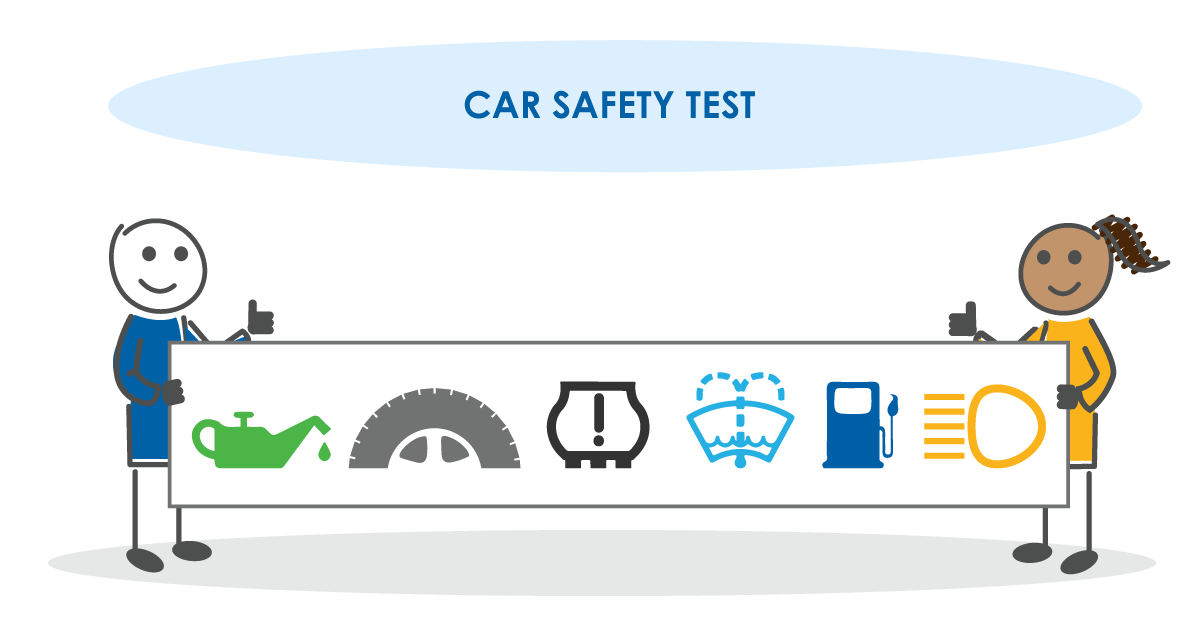
A car safety test is a check you can perform yourself on your vehicle to help prevent breakdowns and keep your car legal on the road. Safety tests can be performed in addition to having the required legal MOT carried out by a qualified professional and could help reduce work needed on your vehicle.
We have put together an easy step by step infographic below:

How to perform a car safety test to help avoid a break down
Oil
Why check oil levels?
To prevent engine from seizing up and damage.
Before you check oil:
Check your car hand book for the grade of oil to use and ideal temperature to check oil.
How to check oil levels:
- Make sure engine is off
- Take out dipstick
- Wipe off oil with paper towel
- Put dipstick back in then take out slowly
- Oil must be between these two indicators
Tyre Tread
Why check tyre tread?
Tyre tread below 1.6mm can affect braking distance, grip to road and steering.
Tyre tread UK legal actions:
If caught with tyre tread below 1.6mm you could recieve a £2,500 fine and 3 penalty points per tyre.
How to check tyre tread:
- Place a twenty pence coin onto the main grooves of the tyre tread
- If you cannot see outer rim of the coin the tread depth is legal
- If you can see outer rim of the coin you must have the tyre replaced
- Check again in at least 3 other areas on each tyre
Tyre Pressure?
Why check tyre pressure?
Over or Under inflated tyres affect breaking distance, steering, fuel efficiency and tyre lifespan.
Before you check tyre pressure:
Find your cars recommended tyre pressure in your cars handbook, behind the drivers car door or inside the fuel cap.
How to check tyre pressure:
- Use an air pressure pump at home or petrol station
- Set to recommended pressure
- Unscrew the valve cap on the tyre
- Attach the pressure gauge to the valve
- The air machine will give a reading before inflating your tyre to the correct pressure you have set
Screen Wash
Why check screenwash levels?
To prevent front and back screen from having decreased visibility.
How to check screen wash levels:
- Find your screen wash reservoir under your bonnet
- It will be brightly coloured with the screen wash symbol on it
- The reservoir can be filled right to the top
- Fill up a mixture of water and screenwash detergent
- Test the wipers to make sure the screenwash flows
- Check windscreen wipers manually to make sure they are not dirty, worn or damaged
Fuel
Why have enough fuel on your journey?
Running out of fuel on a journey can lead to a fixed penalty notice if your breakdown was avoidable.
Lights
Why check all your lights?
Working lights help you, and other drivers to understand how you are driving your car and how you intend to manoeuvre
Before you check lights:
Make sure you can see your lights while you activate them by getting a friend to help or park behind of or in front of a reflective surface.
How to check all lights in sequence:
- Check indicator lights
- Check hazard lights
- Check head lights, side, dipped and full beam
- Check fog lights
- Press brake pedal to check brake lights
- Put car into reverse to check reverse lights



